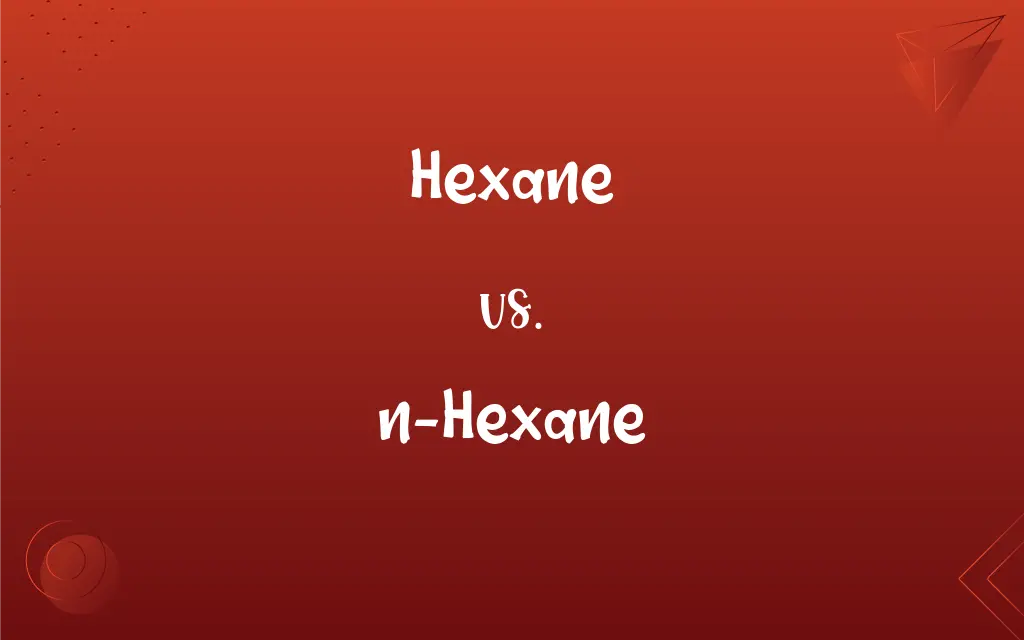Hexane vs. n-Hexane: What's the Difference?
Edited by Aimie Carlson || By Janet White || Published on March 3, 2024
Hexane is a hydrocarbon with six carbon atoms; n-hexane is the straight-chain isomer of hexane, specifically one of its several structural isomers.

Key Differences
Hexane refers to any of the isomers of a saturated hydrocarbon with the molecular formula C6H14. It includes a variety of structural forms, where the arrangement of carbon atoms can vary, leading to different physical and chemical properties. N-hexane, specifically, is the straight-chain isomer of hexane. It is one of the possible hexane isomers, characterized by a continuous chain of six carbon atoms with no branches. N-hexane is often highlighted for its role in industrial applications and its neurotoxic effects with prolonged exposure. It is used in laboratories, in the food industry, and as a cleaning agent.
Hexane in general can refer to any of its isomers, n-hexane is specifically known for its high degree of purity and specific arrangement, making it particularly useful in certain scientific and industrial applications. The distinction is important in contexts where the structural specifics of the compound affect its utility or effects, such as in solvent extraction processes where n-hexane's volatility and non-polarity make it ideal.
The term "hexane" when used without a prefix usually implies a mixture of isomers, not just the straight-chain n-hexane, but also includes other forms like iso-hexane which are used in various industrial solvents. This mixture has different properties, such as boiling points and solvent abilities, compared to pure n-hexane, affecting its suitability for certain applications.
Understanding the difference between hexane and n-hexane is crucial in chemistry and industry due to the distinct properties and applications of the different isomers. N-hexane's specificity is particularly significant in discussions about health and safety due to its neurotoxic potential, while general references to hexane might pertain to broader uses and a mixture of isomers with varied impacts and utilities.
Comparison Chart
Structural Form
Includes several isomers of C6H14.
Straight-chain isomer of hexane.
ADVERTISEMENT
Usage
Used as a solvent in various industries.
Specifically used for its non-polarity and volatility in industrial applications.
Physical Properties
Mixture has varying boiling points.
Boiling point at 69°C, indicating purity.
Health Impact
Toxicity varies among isomers.
Known for neurotoxic effects upon prolonged exposure.
Application Specificity
Less specific, used in general solvent applications.
Preferred in applications requiring specific chemical properties.
Hexane and n-Hexane Definitions
Hexane
A volatile hydrocarbon with the formula C6H14 used widely as a solvent.
Hexane is utilized in the extraction of vegetable oils from seeds.
ADVERTISEMENT
n-Hexane
The straight-chain isomer of hexane, known for its purity and specific applications.
N-hexane is preferred in the food industry for oil extraction due to its efficiency.
Hexane
A chemical with multiple structural variations, each with distinct properties.
Researchers study hexane isomers to understand their different boiling points.
n-Hexane
A chemical with a boiling point of 69°C, useful in scientific research.
The evaporation rate of n-hexane facilitates quick drying in laboratory processes.
Hexane
A solvent in adhesive formulations, particularly in the shoe industry.
Hexane is applied in shoe manufacturing to dissolve and apply adhesives.
n-Hexane
A neurotoxic organic compound used extensively as a non-polar solvent.
Exposure to n-hexane in industrial settings can lead to nerve damage.
Hexane
A component of gasoline, contributing to its octane rating.
Hexane blends in gasoline improve the fuel's performance in engines.
n-Hexane
A specific isomer used in the pharmaceutical industry for its solvent properties.
N-hexane's volatility makes it ideal for extracting medicinal compounds.
Hexane
A mixture of isomers commonly used in industrial and laboratory settings.
The laboratory uses hexane to clean greasy residues from glassware.
n-Hexane
Known for its role in producing special adhesives and rubber cement.
N-hexane is a key ingredient in the formulation of rubber cements.
Hexane
Any of several isomeric colorless flammable liquid hydrocarbons, C6H14, derived from the fractional distillation of petroleum and used as a solvent and as a working fluid in low-temperature thermometers.
n-Hexane
(organic compound) The saturated aliphatic hydrocarbon (CH3(CH2)4CH3).
Hexane
(organic compound) Any of five isomeric aliphatic hydrocarbons, C6H14. They are colorless, volatile liquids.
Hexane
Any one of five hydrocarbons, C6H14, of the paraffin series. They are colorless, volatile liquids, and are so called because the molecule has six carbon atoms.
Hexane
A colorless flammable liquid alkane derived from petroleum and used as a solvent
FAQs
Are all hexane isomers equally toxic?
Toxicity varies; n-hexane is particularly noted for neurotoxic effects.
Why is n-hexane used in industrial applications?
Its volatility and non-polarity make it ideal for solvent extraction processes.
How does n-hexane differ from other hexane isomers?
N-hexane is the straight-chain isomer, without branching, unlike other hexane isomers.
Can hexane be found in consumer products?
Yes, it's used in adhesives, varnishes, and sometimes in food processing.
What makes n-hexane a preferred solvent in laboratories?
Its ability to dissolve a wide range of substances without interfering with chemical reactions.
What is hexane?
Hexane is a hydrocarbon with six carbon atoms, existing in several isomeric forms.
Why is n-hexane used in food oil extraction?
It efficiently extracts oil without adding unwanted flavors or odors.
Can hexane contamination occur in food products?
Yes, but regulations limit solvent residues to safe levels.
What are the environmental impacts of hexane?
It's a volatile organic compound contributing to air pollution and photochemical smog.
How are hexane isomers separated?
Through distillation and refining processes based on their boiling points.
What precautions should be taken when handling n-hexane?
Use in well-ventilated areas and wear protective equipment to avoid inhalation and skin contact.
Is hexane present in gasoline?
Yes, as part of the mixture of hydrocarbons improving octane rating.
How does exposure to n-hexane affect health?
Prolonged exposure can lead to nerve damage and other neurotoxic effects.
What safety measures are recommended for hexane use in industries?
Adequate ventilation, personal protective equipment, and strict adherence to safety protocols.
What role does hexane play in the chemical synthesis?
It's used as a reaction medium and solvent for various organic syntheses.
What alternatives exist for hexane in industrial applications?
Safer solvents and processes are being developed to reduce hexane use.
How do regulations affect hexane use?
Regulations limit exposure and residues in products to protect health and environment.
How is n-hexane removed from extracted oils?
By evaporation and refining processes that eliminate solvent residues.
Why is the specific identification of n-hexane important in chemical processes?
Its unique properties affect the outcome and efficiency of chemical reactions and extractions.
How is n-hexane's neurotoxicity diagnosed?
Through clinical evaluation and monitoring of exposure symptoms.
About Author
Written by
Janet WhiteJanet White has been an esteemed writer and blogger for Difference Wiki. Holding a Master's degree in Science and Medical Journalism from the prestigious Boston University, she has consistently demonstrated her expertise and passion for her field. When she's not immersed in her work, Janet relishes her time exercising, delving into a good book, and cherishing moments with friends and family.
Edited by
Aimie CarlsonAimie Carlson, holding a master's degree in English literature, is a fervent English language enthusiast. She lends her writing talents to Difference Wiki, a prominent website that specializes in comparisons, offering readers insightful analyses that both captivate and inform.
































































